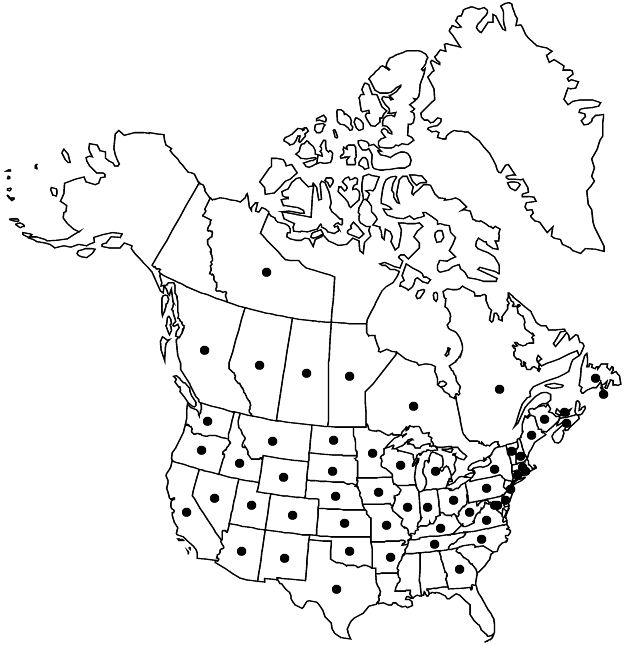Prunus virginiana
Sp. Pl. 1: 473. 1753.
Shrubs or trees, often suckering, 10–60(–100) dm, not thorny. Twigs with terminal end buds, glabrous or hairy. Leaves deciduous; petiole 4–22(–27) mm, usually glabrous, sometimes hairy, glandular distally, glands 2, discoid; blade obovate or elliptic to ovate or oblanceolate, 2.5–9(–11) × 1.2–5(–6.6), base cuneate to rounded or subcordate, margins serrulate to serrate, teeth ascending to spreading, usually sharp, eglandular, sometimes callus-tipped, obscurely glandular, lateral veins 6–13 per side, raised abaxially, apex acuminate, acute, or obtuse, abaxial surface glabrous or hairy (especially along midribs), adaxial glabrous. Inflorescences 18–64-flowered, racemes; central axes (18–)40–110(–130) mm, leafy at bases. Pedicels 2–8(–16) mm, usually glabrous, rarely hairy. Flowers blooming after leaf emergence; hypanthium cupulate, 1.5–3 mm, glabrous externally; sepals erect-spreading to reflexed, semicircular, 0.7–1.4 mm, margins erose, usually glandular-toothed, sometimes nearly eglandular, surfaces glabrous; petals white, obovate to suborbiculate, 2–5(–7) mm; ovaries glabrous. Drupes red, purple, dark purple, or black, globose, 6–14 mm, glabrous; hypanthium deciduous, leaving discs at bases of drupes; mesocarps fleshy; stones subglobose to ellipsoid, not flattened, ± smooth.
Distribution

Alta., B.C., Man., N.B., N.S., N.W.T., Nfld. and Labr. (Nfld.), Ont., P.E.I., Que., Sask., Ariz., Ark., Calif., Colo., Conn., D.C., Del., Ga., Idaho, Ill., Ind., Iowa, Kans., Ky., Maine, Mass., Md., Mich., Minn., Mo., Mont., N.C., N.Dak., N.H., N.J., N.Mex., N.Y., Nebr., Nev., Ohio, Okla., Oreg., Pa., R.I., S.Dak., Tenn., Tex., Utah, Va., Vt., W.Va., Wash., Wis., Wyo., Mexico.
Discussion
Varieties 2 (2 in the flora).
Because of variation in the degree of hairiness on branches and leaves, thickness of leaves, leaf shape, sizes of racemes and flowers, and colors of fruits, Prunus virginiana has been split into forms, varieties, and segregate species. When viewed on a continental scale, most of the key characteristics used to separate these taxa intergrade enough so as to be useless.
The most useful distinction is between chokecherries found east of the Rocky Mountains and those found from the mountains westward. They differ in leaf shape and raceme size; the variation is imperfectly correlated. The eastern plants generally have their larger leaves obovate with lengths less than two times widths, racemes typically less than 7 cm, and petals to 4 mm. Plants of the Rockies and west have longer racemes and larger petals, and generally their larger leaves are elliptic to oblanceolate leaves with lengths two or more times widths. Distinctions between the eastern and western varieties are least obvious from Montana to eastern Washington north into British Columbia, where the varietal ranges overlap. Plants of the High Plains show intergradation between those of the Rockies and those of the East. The taxonomic solution provided here is a single species of chokecherry in North America with an eastern and a western variety that overlap in range along a line from northeastern New Mexico to southwestern British Columbia.
Selected References
None.
Key
| 1 | Racemes (18–)40–70(–95) mm; petals (2–)2.5–4 mm; leaf blades usually obovate, lengths of larger less than 2 times widths. | Prunus virginiana var. virginiana |
| 1 | Racemes (30–)60–110(–130) mm; petals 4–5(–7) mm; leaf blades elliptic to oblanceolate, lengths of larger at least 2 times widths. | Prunus virginiana var. demissa |